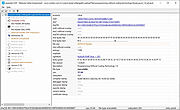 |
PeStudio Standard v9.09
PeStudio Standard v9.09
pestudio is used by many Cyber Emergency Response Teams (CERT) worldwide in order to perform malware initial assessments.
Malicious software often attempts to hide its intents in order to evade early detection and static analysis. In doing so, it often leaves suspicious patterns, unexpected metadata, anomalies and other indicators.
The goal of pestudio is to spot these artifacts in order to ease and accelerate Malware Initial Assessment. The tool uses a powerful parser and a flexible set of configuration files that are used to detect various types of indicators and determine thresholds. Since the file being analyzed is never started, you can inspect unknown or malicious executable file, trojan and ransomware without any risk of infection.
features
pestudio implements a rich set of features that is especially designed to retrieve every single detail of any executable file. Results are checked against the Microsoft specification. Additionally, the content of the file being analyzed is checked against several white and black lists and thresholds.
pestudio can query Antivirus engines hosted by Virustotal. Only the MD5 of the file being analyzed is sent. This feature can be switched ON or OFF using an XML file included with pestudio.
Even a suspicious binary file must interact with the operating system in order to perform its activity.
pestudio retrieves the libraries and the functions referenced. Several XML files are used to blacklist functions (e.g. Registry, Process, Thread, File, etc). Blacklist files can be customized and extended according to your own needs. pestudio brings out the intent and purpose of the application analyzed.
Resources sections are commonly used by malware to host payload.
pestudio detects many embedded file types (e.g. EXE, DLL, SYS, PDF, CAB, ZIP, JAR, etc ). Detected items can be saved to a file, allowing therefore the possibility of further analysis.
The goal of ... |
 |
9,412 |
Dec 27, 2020
Marc Ochsenmeier  |













